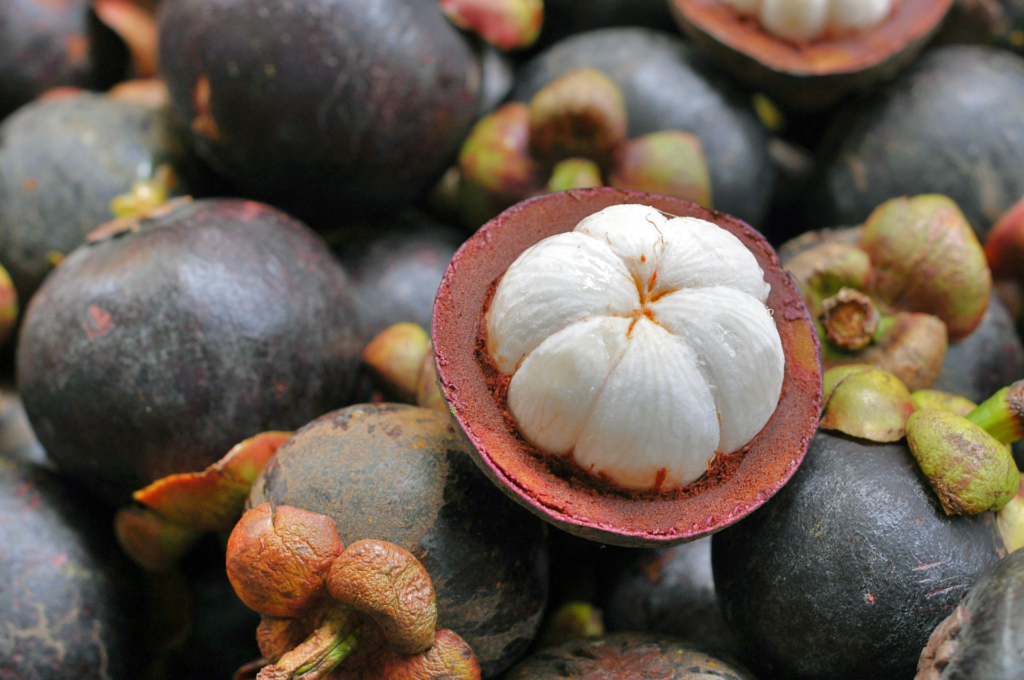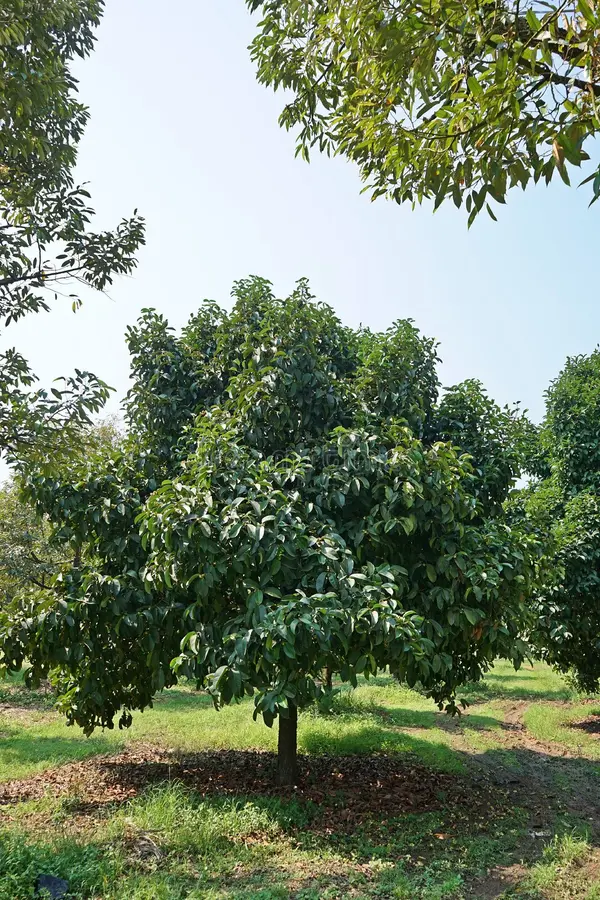

Mangosteen has been a big interest of mine this past summer, and I’ve had a good time researching it. Mangosteen is a tropical plant with a sweet, tangy flavor and vibrant purple rind, with therapeutic potential, cultivated in Southeast Asia. Its pericarp has been traditionally used to treat various ailments, including abdominal pain and infections. Experimental studies reveal that Mangosteen extracts exhibit antioxidant, antitumoral, anti-inflammatory, antibacterial, and antiviral properties due to bioactive compounds like xanthones.
Growing Mangosteen

- Ideal Growing Conditions
Mangosteen thrives in tropical climates, requiring specific conditions for optimal growth: - Climate: Mangosteen prefers warm and humid weather, with temperatures ranging between 25°C to 35°C (77°F to 95°F). It is sensitive to cold temperatures and frost, making it unsuitable for temperate climates.
- Soil: The fruit grows best in well-draining, fertile soils rich in organic matter. Sandy loam or clay loam soils with a pH between 5.5 and 7.0 are ideal for mangosteen cultivation.
- Rainfall: Mangosteen trees require consistent rainfall, ideally between 1500mm to 2500mm annually. However, they also need a dry season to facilitate flowering and fruit development.
Medicinal Properties
Anti-inflammatory Properties
Specific Uses:
- Conditions Treated: Arthritis, gout, and other inflammatory diseases.
- Preparation Method: Traditional healers would often dry the mangosteen pericarp and then boil it in water to create a concentrated decoction. This tea would be consumed regularly to help reduce inflammation and pain.
- Cultural Beliefs: The mangosteen was often viewed as a sacred fruit, symbolizing purity and health. Its use in treating inflammation was believed to restore balance in the body, as traditional medicine systems often emphasize the importance of harmony between bodily systems.
- Modern Research: Recent studies have begun to explore the mechanisms behind these anti-inflammatory effects, suggesting that xanthones may inhibit the production of pro-inflammatory cytokines and enzymes, providing a scientific basis for their traditional use.
Cultural Context:
In many Southeast Asian cultures, chronic inflammatory conditions were common due to lifestyle and dietary factors. The mangosteen pericarp was often recommended as a natural remedy, believed to balance bodily humors and alleviate pain.
Antioxidant Effects
Specific Uses:
- Conditions Treated: Skin conditions, fatigue, and chronic diseases like diabetes and heart disease.
- Preparation Method: The dried pericarp could be ground into a powder and mixed with honey or other herbal ingredients to enhance flavor and efficacy. This mixture would be taken daily as a tonic.
- Cultural Beliefs: In traditional Chinese medicine (TCM), the concept of “Qi” (life force) is central. The antioxidant properties of mangosteen were believed to help strengthen the Qi, thus improving overall health and longevity.
- Modern Research: Studies have confirmed that the antioxidant activity of xanthones can help neutralize free radicals, potentially reducing the risk of chronic diseases and supporting overall health.
Cultural Context:
In traditional medicine systems, such as Ayurveda and Traditional Chinese Medicine (TCM), the concept of oxidative stress was understood in terms of imbalance. The antioxidant properties of mangosteen were utilized to restore balance and promote vitality.
Digestive Health
Specific Uses:
- Conditions Treated: Diarrhea, dysentery, and general gastrointestinal discomfort.
- Preparation Method: A common preparation involved boiling the dried rind to create a tea, which was consumed to help firm up stools. In some cultures, the powdered pericarp was mixed with rice or other foods to aid digestion.
- Cultural Beliefs: In Thai traditional medicine, the mangosteen was often associated with the concept of cleansing the body. It was believed that the pericarp helped eliminate toxins, thus promoting digestive health and overall well-being.
- Modern Research: Some studies suggest that the tannins in the pericarp may indeed have astringent properties, supporting its traditional use in treating diarrhea.
Cultural Context:
In regions where waterborne diseases were prevalent, the use of the mangosteen pericarp as a remedy for digestive issues was particularly significant. It was often included in the diets of those recovering from gastrointestinal illnesses.
Antimicrobial Properties
Specific Uses:
- Conditions Treated: Skin infections, wounds, and respiratory infections.
- Preparation Method: The pericarp could be ground into a paste and applied topically to infected areas. Some cultures also prepared infusions that were used as gargles for throat infections.
- Cultural Beliefs: In various cultures, the mangosteen was considered a “guardian” against infections. Its use in treating wounds was often accompanied by rituals or prayers for protection and healing.
- Modern Research: Laboratory studies have shown that extracts from the mangosteen pericarp exhibit antimicrobial activity against a range of bacteria and fungi, supporting its historical use as a natural remedy for infections.
Cultural Context:
The antimicrobial properties of the mangosteen pericarp were particularly valued in rural communities where access to modern medicine was limited. It was a common practice to use natural remedies to prevent infections and promote healing.
Skin Health
Specific Uses:
- Conditions Treated: Eczema, psoriasis, acne, and general skin irritation.
- Preparation Method: A paste made from ground dried pericarp mixed with coconut oil or aloe vera was often applied directly to the skin. In some cases, the pericarp was steeped in water, and the resulting infusion was used as a wash for irritated skin.
- Cultural Beliefs: In traditional beauty practices, particularly in regions like Thailand, the mangosteen was revered for its ability to promote clear and healthy skin. It was often used in beauty rituals, and its application was thought to enhance one’s natural beauty and vitality
- Modern Research: Contemporary studies are exploring the potential of mangosteen extracts in cosmetic formulations, particularly for their anti-aging and skin-soothing properties.
Cultural Context:
In cultures where skin conditions were prevalent due to environmental factors, the mangosteen pericarp was a go-to remedy. It was often included in beauty rituals and skincare regimens, reflecting the holistic approach to health and beauty.
Weight Management and Metabolic Health
Specific Uses:
- Conditions Treated: Obesity, metabolic syndrome, and related health issues.
- Preparation Method: The pericarp was sometimes included in herbal mixtures or teas aimed at boosting metabolism. It could be combined with other herbs known for their weight loss properties, such as green tea or bitter gourd.
- Cultural Beliefs: In traditional practices, maintaining a healthy body weight was often linked to spiritual and physical well-being. The mangosteen was seen as a natural remedy that could help individuals achieve balance and harmony in their lives.
- Modern Research: While more research is needed, preliminary studies suggest that xanthones may influence fat metabolism, potentially supporting traditional claims about weight management.
Cultural Context:
In traditional practices, maintaining a healthy weight was linked to overall well-being. The use of the mangosteen pericarp in weight management reflects a broader understanding of diet and health in these cultures.